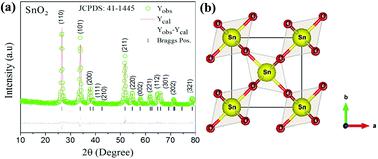当前位置:
X-MOL 学术
›
New J. Chem.
›
论文详情
Our official English website, www.x-mol.net, welcomes your feedback! (Note: you will need to create a separate account there.)
In vitro and in silico molecular docking studies of Rheum emodi-derived diamagnetic SnO2 nanoparticles and their cytotoxic effects against breast cancer
New Journal of Chemistry ( IF 3.3 ) Pub Date : 2021-1-11 , DOI: 10.1039/d0nj04670a Deepika Sharma 1, 2 , Naveen Kumar 2, 3, 4 , Tarang Mehrotra 5, 6, 7, 8 , Naveed Pervaiz 2, 4, 9, 10 , Lokesh Agrawal 11, 12, 13, 14, 15 , Shalini Tripathi 8, 16, 17, 18 , Abhishek Jha 2, 19, 20, 21 , Thanasis Poullikkas 15, 22, 23, 24, 25 , Ravinder Kumar 2, 4, 9, 10 , Lalita Ledwani 1, 2
New Journal of Chemistry ( IF 3.3 ) Pub Date : 2021-1-11 , DOI: 10.1039/d0nj04670a Deepika Sharma 1, 2 , Naveen Kumar 2, 3, 4 , Tarang Mehrotra 5, 6, 7, 8 , Naveed Pervaiz 2, 4, 9, 10 , Lokesh Agrawal 11, 12, 13, 14, 15 , Shalini Tripathi 8, 16, 17, 18 , Abhishek Jha 2, 19, 20, 21 , Thanasis Poullikkas 15, 22, 23, 24, 25 , Ravinder Kumar 2, 4, 9, 10 , Lalita Ledwani 1, 2
Affiliation

|
Green-route-bioengineered nanoparticles have received significant attention for diagnosis and treatment of cancer in the medical technology era due to their non-toxic nature, cost-friendliness, and energy efficiency. Interestingly, tin oxide nanoparticles (SnO2 NPs) were synthesized from the root extract of Himalayan herb Rheum emodi by a cost-effective and environmentally friendly method. Structural analysis revealed that biosynthesized SnO2 NPs show a tetragonal crystal symmetry with the space group P4/2mnm as confirmed by the Rietveld refinement method. By transmission electron microscopy (TEM), the average particle diameter was established as ∼40 nm with a spherical shape. Furthermore, by Fourier transform infrared (FTIR) spectroscopy analysis, it was revealed that metabolites (hydroxyanthraquinones) present in Rheum emodi root extracts act as capping, reducing and stabilizing agents aiding in the synthesis of SnO2 NPs. Amongst the major metabolites aiding the anticancer activity, aloe-emodin, archin (emodin), chrysophanic acid (chrysophanol) and parietin (physcion) are established anti-cancer agents. It is noteworthy that the Rheum emodi root extract-derived SnO2 NPs deployed the diamagnetic character in a room-temperature magnetic characterization environment of a vibrating sample magnetometer (VSM). It was observed that the room-temperature photoluminescence spectra revealed a rich violet emission band of wavelength ∼419 nm. In addition, the anticancer potential of Rheum emodi root extract-derived SnO2 NPs was investigated against the breast cancer cell line MDA-MB-231 at different concentrations. Finally, we docked hydroxyanthraquinones (aloe-emodin, archin, chrysophanic acid and parietin) with anti-cancer proteins (estrogen receptor alpha, epidermal growth factor receptor, N-myristol transferase, mammalian target of rapamycin, vascular endothelial growth receptor-2 and progesterone receptor) to confirm the anticancer potential of Rheum emodi.
中文翻译:

大黄大肠来源的抗磁性SnO2纳米粒子的体外和计算机分子对接研究及其对乳腺癌的细胞毒性作用
绿色路线生物工程纳米颗粒由于其无毒性质,成本友好性和能源效率,在医疗技术时代已被广泛用于癌症的诊断和治疗。有趣的是,通过一种经济高效且环保的方法,从喜马拉雅草药大黄的根提取物中合成了氧化锡纳米颗粒(SnO 2 NPs)。结构分析表明,生物合成的SnO 2 NPs具有四方晶对称性,空间群P 4/2 mnm由Rietveld精炼方法证实。通过透射电子显微镜(TEM),平均粒径为〜40nm,呈球形。此外,通过傅立叶变换红外(FTIR)光谱分析,发现大黄根提取物中存在的代谢物(羟基蒽醌)充当封端,还原和稳定剂,有助于合成SnO 2 NP。在有助于抗癌活性的主要代谢产物中,芦荟大黄素,阿奇菌素(大黄素),金瓜芬酸(chsopholanol)和派瑞汀(physcion)已被确立为抗癌剂。值得注意的是,大黄大黄根提取物衍生的SnO 2NP在振动样品磁力计(VSM)的室温磁性表征环境中部署了抗磁性特征。观察到,室温光致发光光谱显示出丰富的紫光发射带,其波长约为419 nm。此外,研究了大黄大黄根提取物衍生的SnO 2 NPs在不同浓度下对乳腺癌细胞MDA-MB-231的抗癌潜力。最后,我们将羟基蒽醌(芦荟大黄素,阿奇菌素,金瓜氨酸和parietin)与抗癌蛋白(雌激素受体α,表皮生长因子受体,N-myristol转移酶,雷帕霉素的哺乳动物靶标,血管内皮生长受体2和孕激素受体)以确认大黄的抗癌潜力。
更新日期:2021-01-11
中文翻译:

大黄大肠来源的抗磁性SnO2纳米粒子的体外和计算机分子对接研究及其对乳腺癌的细胞毒性作用
绿色路线生物工程纳米颗粒由于其无毒性质,成本友好性和能源效率,在医疗技术时代已被广泛用于癌症的诊断和治疗。有趣的是,通过一种经济高效且环保的方法,从喜马拉雅草药大黄的根提取物中合成了氧化锡纳米颗粒(SnO 2 NPs)。结构分析表明,生物合成的SnO 2 NPs具有四方晶对称性,空间群P 4/2 mnm由Rietveld精炼方法证实。通过透射电子显微镜(TEM),平均粒径为〜40nm,呈球形。此外,通过傅立叶变换红外(FTIR)光谱分析,发现大黄根提取物中存在的代谢物(羟基蒽醌)充当封端,还原和稳定剂,有助于合成SnO 2 NP。在有助于抗癌活性的主要代谢产物中,芦荟大黄素,阿奇菌素(大黄素),金瓜芬酸(chsopholanol)和派瑞汀(physcion)已被确立为抗癌剂。值得注意的是,大黄大黄根提取物衍生的SnO 2NP在振动样品磁力计(VSM)的室温磁性表征环境中部署了抗磁性特征。观察到,室温光致发光光谱显示出丰富的紫光发射带,其波长约为419 nm。此外,研究了大黄大黄根提取物衍生的SnO 2 NPs在不同浓度下对乳腺癌细胞MDA-MB-231的抗癌潜力。最后,我们将羟基蒽醌(芦荟大黄素,阿奇菌素,金瓜氨酸和parietin)与抗癌蛋白(雌激素受体α,表皮生长因子受体,N-myristol转移酶,雷帕霉素的哺乳动物靶标,血管内皮生长受体2和孕激素受体)以确认大黄的抗癌潜力。



























 京公网安备 11010802027423号
京公网安备 11010802027423号